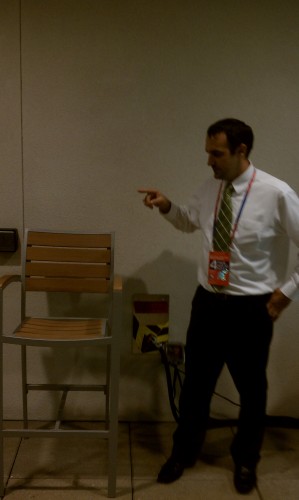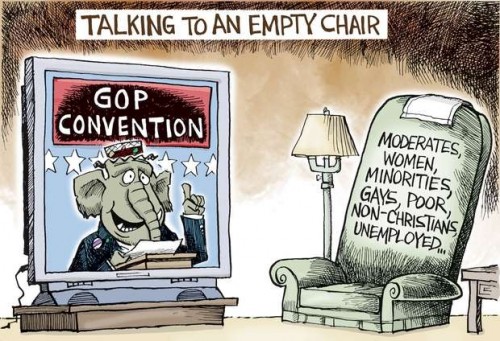
After the final night of the convention, Robert Gehrke (@RobertGehrke) a reporter with the Salt Lake City Tribune, had a colleague take a picture of him pointing at a chair. He was mimicking Clint Eastwood’s now infamous prime-time speech at the Republican National Convention. The performance was (almost) undeniably awkward and strange. Rachel Maddow described Eastwood’s one-man improv skit as, “the weirdest thing I have ever seen at a political convention in my entire life.” Before the network morning shows could pass judgement, twitter users had developed an entire visual language that not only made fun of Eastwood, but the entire Republican party. The performative internet meme called “#eastwooding” had taken shape within hours of Gehrke’s tweet, offering thousands of people a simple framework for creating their own political satire.
Let me back up for a second and allow Gehrke to describe the genesis of #eastwooding. He writes,
It struck me that he could stand next to the stool and recreate Clint Eastwood’s unforgettable convention speech that we saw just an hour earlier and I could toss a photo on Twitter of him “Eastwooding.”
[…]
Ana Marie Cox, formerly The Wonkette, snagged it and retweeted it to her 1.3 million followers with the message: “INTERNET You know what to do,” and the #Eastwooding meme had begun.
Tens of thousands of people picked up on it and it spread all over the Web.
I think it is important to note that not only does Ana Marie Cox (@anamariecox) have a large following, but that she gained much of her fame from the hilarious blog that she started (and has since left) called The Wonkette. The blog covers real political issues, but is written with lots of hyperbole, tongue-in-cheek metaphors, and blingee gifs. It is safe to say that her following is probably young, enjoys political humor, and is internet-savvy. In other words, sending something to Ana Marie Cox’s followers is not the same as sending it to The McLaughlin Group’s followers:
Beyond the fact that The McLaughlin Group has far less followers, those followers are not going to “know what to do.” Cox’s followers, on the other hand, knew exactly what that picture meant and what was being asked of them:
https://twitter.com/elisefoley/status/241383763949547520
https://twitter.com/delrayser/status/241391128904097792
https://twitter.com/dylanmatt/status/241388051023142912
These three examples depict the usual permutations of, what I have termed, performative internet memes. The permutations are the result of friendly competition among twitter users who want a brief shot at fame. In order to stand out, a user has to play off the basic structure of the meme. It is easy to take a picture of yourself pointing at an empty chair, therefore, in order to stand out, one must add new material or place the chair in an odd or surprising situation. The first adds an additional prop to imply that Eastwood was intoxicated or came up with the idea while intoxicated. The second tweet relies on an absurd premise- a dog deriding the President of the United States. The third is an appropriation of an existing photo of the President, reinterpreted as #eastwooding. (This does not include all of the non-performative instantiations of #eastwooding, wherein photoshop is used to place things in and around the original empty chair). The speech act (tweet act?) of associating the photo with the meme is enough to give the image an entirely new meaning. One need not take a photo at all to participate in the political humor. As Jenny Davis has pointed out in the past, a meme acts as a both sign and the signifier. A corgi staring at a stool and the POTUS sitting next to an empty chair did not have a semiotic relationship until Gehrke and Cox invited the Internet to go #eastwooding. Now these pictures appear to (and, in fact, do) share a similar grammar and tell the same myth. You do not need to know the genesis of the meme in order to understand it, or even contribute your own, which is exactly why it is an effective and popular method of talking about the event. #eastwooding provides a forum for lampooning the GOP, while also acknowledging the shared experience of watching a movie star waste valuable prime time minutes by talking to a piece of furniture.
It would be fair if, at this point, you are still asking how this qualifies as political satire. How is this anything more than making fun of an elderly man’s poorly executed joke? The answer comes in two parts. First, the satire is not the individual posts, but the existence (and thus performance) of the meme itself. Jon Stewart could interview an empty chair on The Daily Show, and we would immediately recognize it as satire. For participatory comedy however, the hilarity does not come from a single performance, but from the innovation that happens in between and across individual performances. Eastwood’s performance was supposed to be a source of cultural capital, but instead became the butt of a thousand jokes. #eastwooding was one of the major stories to come out of the convention, (see here, here, here ,here, and here for a representative sample of a very large population) and even garnered the attention of the Obama campaign:
Second, #eastwooding is satire because it tells the opposite story that Eastwood and the GOP wanted to tell. Like any good political satire, it inverts the meaning of the original statement: Eastwood is not a source of brooding masculinity, but of impotent rambling and confusion. It speaks to the existing criticism that the Republicans (and especially Mitt Romney) are out-of-touch. When they speak, no one is listening. Political cartoonist Joe Heller sums this up with his own empty chair:

The #eastwooding meme will probably die off by next week. Invisible Barack Obama does not have the same staying power as the invisible sandwich. But by Monday #eastwooding will have served its purpose. It helped thousands of people poke fun at what was supposed to be a serious event. It created a grammar of empty chairs, pointing, and Barack Obama that made it easy to lampoon a presidential candidate when he needed positive press the most. It fed a narrative emphasizing the out-of-touch nature of the Republican party. #eastwooding creating a favorable environment for the creation of similar memes like @invisibleobama: a parody twitter account that gathered more followers than Romney and Ryan added to their accounts, combined. #eastwooding is funny because it exemplifies all of the problems of the modern GOP in a simple, easy-to-enact gesture. It is appropriate then, that a party that is made up of old white men would be so perfectly critiqued by a technology (and mythology!) that runs on popular participation.
Follow David on Twitter: @da_banks

Comments 9
Laroquod — September 1, 2012
"How is this anything more than making fun of an elderly man’s poorly executed joke? The answer comes in two parts...."
You make good points. It *is* something more than making fun of an old man's incompetence. However, that still doesn't really excuse it for being that, nor does it make the old man any less pitiable. That is why this kind of satire directed primarily at the wrong target has such a lousy aftertaste. It reminds me of when everybody piled on a young girl for singing a song 'Friday' that merely parrotted and held a mirror to the vacuity of society in general.
Lola Marina (@lolapowers) — September 1, 2012
This is cyberspace at its most humorous moment. We all had great laughs and will continue to have them for quite a while. I do feel kind of bad for East wood. I don't think he knew that his little skit would be the butt of jokes for everyone to feast on!
Deborah Weinstein — September 2, 2012
Brilliant post! Thank you.
Fuck yeah, Obama | El aire viciado — January 22, 2013
[...] intervenciones de la convención; solo la estupidez de Eastwood, trending topic en Twitter como #eastwooding. Aunque lo mejor de todo fue la respuesta del presidente, que respondió a la vez con fuerza y [...]
#Standingman: The Meme for the Masses » Cyborgology — June 18, 2013
[...] an overtly political meme because, unlike other performative memes like #planking, #owing, or even #eastwooding, it is meant to demonstrate a belonging to a [...]
The Civic Beat: World Report » #Standingman: The Meme for the Masses — June 25, 2013
[...] an overtly political meme because, unlike other performative memes like #planking, #owing, or even #eastwooding, it is meant to demonstrate a belonging to a [...]
The Civic Beat Reader #Standingman: The Meme for the Masses — October 2, 2013
[...] an overtly political meme because, unlike other performative memes like #planking, #owing, or even #eastwooding, it is meant to demonstrate a belonging to a [...]
Fuck yeah, Obama | Para que todo encaje — February 4, 2014
[…] intervenciones de la convención; solo la estupidez de Eastwood, trending topic en Twitter como #eastwooding. Aunque lo mejor de todo fue la respuesta del presidente, que respondió a la vez con fuerza y […]
#Standingman: The Meme for the Masses | David A Banks — March 6, 2014
[…] political meme because, unlike other performative memes like #planking, #owing, or even #eastwooding, it is meant to demonstrate a belonging to a […]